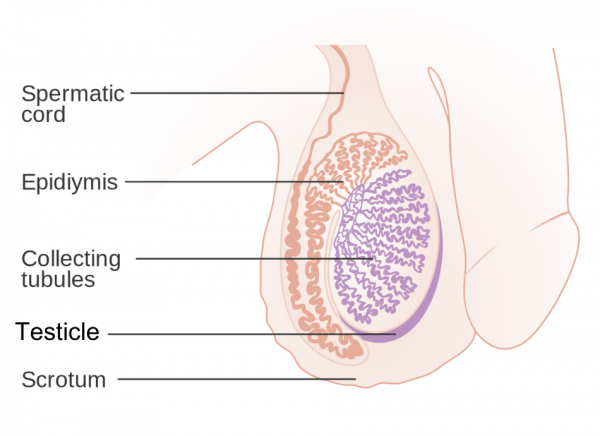Testicle lumps and swelling
Also known as scrotal masses
Key points about testicle lumps and swelling
- Lumps and swelling in your testicles (balls) are fairly common and there are many causes.
- In most cases, the cause is not serious, but know when to see your healthcare provider to see if it's serious or not.
- Regularly examining your testicles will help you know what your normal is, so you are more likely to notice changes early.
- The treatment will depend on the cause, but early treatment is best.

The image below shows the anatomy of the testicle.

Image credit: CRUK via Wikimedia Commons
There are many reasons why your testicles may develop a lump or become swollen.
The most common causes include:
- enlarged veins within the scrotum or a build-up of fluid around the testicle (called a hydrocoele, pronounced hi-dro-seel)
- cysts caused by a collection of fluid in the epididymis (a coiled tube that lies beside each testicle and stores and carries sperm)
- inflammation of the epididymis and testicles, often caused by infection – see epididymo-orchitis
- a hernia – where fatty tissue or a part of your bowel pokes through into your groin.
A less common but more serious cause could be testicular cancer. You should always see a healthcare provider if you notice any lumps or swelling in your testicles. If it's painful, seek advice urgently.
See your healthcare provider immediately if you have sudden, unbearable pain in your testicles or abdomen (tummy). This could be a sign that your testicle has become twisted, which needs urgent hospital treatment.
Otherwise, see your healthcare provider if you have:
- a lump in your testicles – this can be a sign of testicular cancer and it's easier to treat if it’s found early
- red or swollen testicles
- a change in the shape or feel of your testicles
- an ongoing ache, pain or discomfort in your testicles.
To find out what is causing your testicular lump or swelling, your healthcare provider may:
- look at and feel your testicles
- shine a light through the skin of your scrotum, to check for fluid build-up and see the size and location of any lump
- request a urine (pee) sample and/or blood test
- refer you to have an ultrasound scan. This is a painless test that uses sound waves to create images of organs and structures inside your body.
The treatment will depend on the cause.
- If there's a bacterial infection, antibiotics may be prescribed.
- Viral infections, (eg, mumps) are usually treated with rest, ice and pain relief medicine.
- Non-cancerous lumps might be left untreated or surgically removed, repaired or drained.
- Testicular cancer requires urgent treatment. This may include surgery, chemotherapy or radiotherapy.
Your healthcare provider will discuss your diagnosis and any treatment required with you.
Regularly examining your testicles will help you know what your normal is, so you're more likely to notice changes early and can get prompt medical advice.
To do a testicular self-exam, follow these steps:
- Examine your testicles once a month, after a hot bath or shower – heat helps relax your scrotum, making it easier to check.
- Stand in front of a mirror. Look for swelling on the skin of your scrotum.
- Cup your scrotum in one hand. Observe if it feels different from normal.
- Using both hands, gently roll each testicle between your thumb and fingers to feel for lumps. The testicles are normally smooth, oval shaped and firm. Often one will be slightly larger than the other.
- At the back of your testicles is the epididymis. This coiled tube normally feels ropey and can grow harmless cysts.
If you find a lump or anything new or unusual, call your healthcare provider as soon as possible.
Here's a video on how to examine your testicles yourself.
Video: Testicular cancer self-examination
(Prostate Cancer Foundation NZ, 2017)
Scrotal lumps, pain and swelling(external link) Patient Info, UK
Testicular lumps and swellings(external link) NHS, UK
Get the lowdown – our guide to checking your nuts(external link) Movember Foundation NZ
Apps
Self-management and healthy living apps
References
- Lumps in the groin and scrotum(external link) Patient Info Professional, UK, 2024
- Testicular lumps and swellings(external link) NHS, UK, 2024
Acute scrotal pain or swelling – paediatric(external link) The Royal Children’s Hospital Melbourne, Australia, 2020
Epididymo-orchitis(external link) Patient Info Professional, UK, 2022
Lumps in the groin and scrotum(external link) Patient Info Professional, UK, 2024
See our page Men's health for healthcare professionals
Apps
Credits: Healthify editorial team. Healthify is brought to you by Health Navigator Charitable Trust.
Reviewed by: Dr Art Nahill, Consultant General Physician and Clinical Educator.
Last reviewed:





